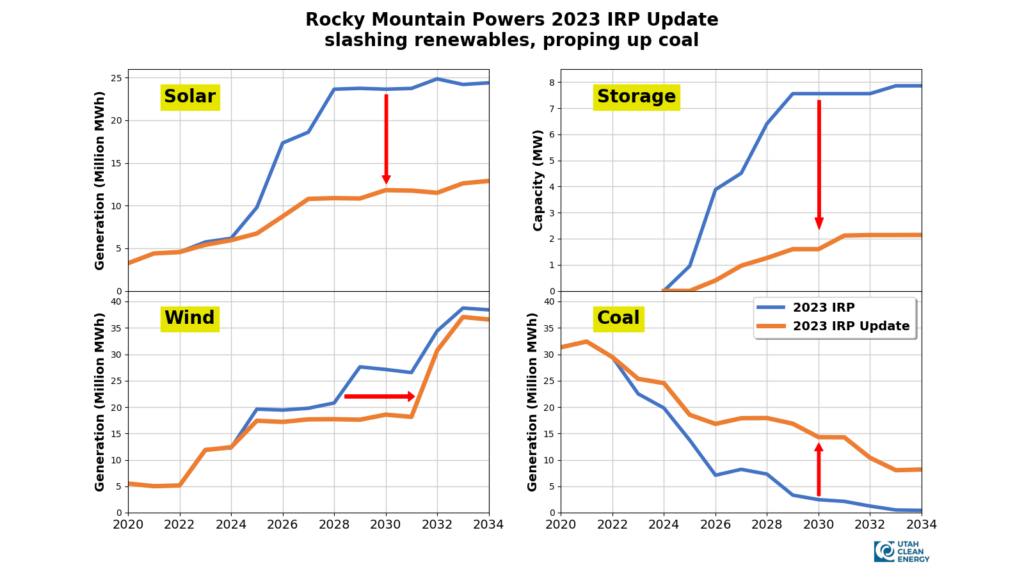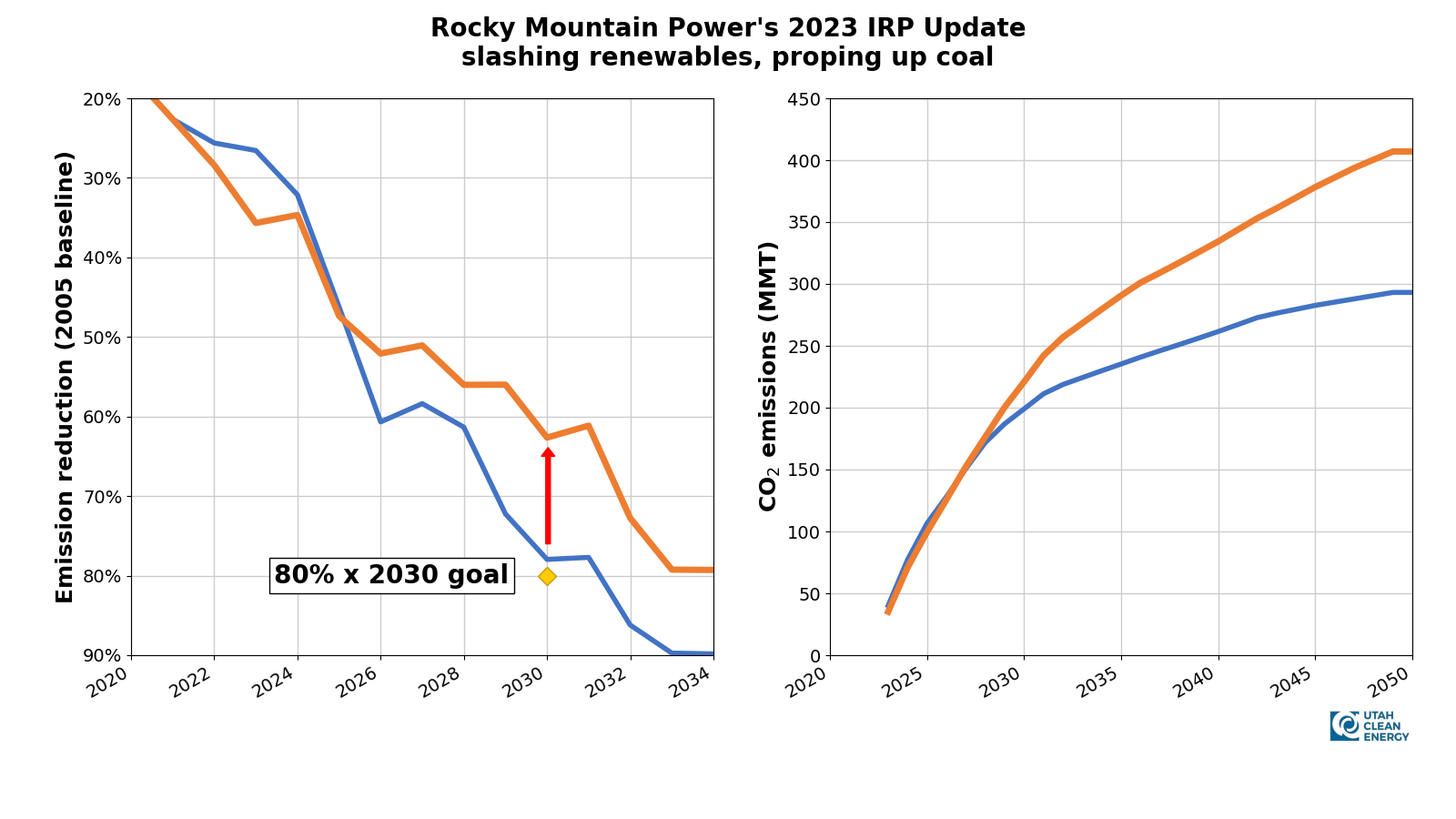This time last year, Utah Clean Energy was celebrating Rocky Mountain Power’s 2023 Integrated Resource Plan (IRP). This is the plan that lays out what combination of energy resources the utility will use over the next decade and beyond to power our lives. In short, the 2023 IRP moved Utah toward an electricity grid powered primarily by pollution-free renewable energy and associated battery storage. It was a practical, yet forward-thinking plan that showed we can have affordable, reliable energy by harnessing our incredible solar, wind, storage, and energy efficiency potential. The utility’s energy plan would have resulted in a nearly 80% reduction of emissions by 2030 compared to a 2005 baseline, a win-win for all of Utah.
Fast forward to April 1, 2024, Rocky Mountain Power took a dramatic and calamitous step backwards when it updated the IRP to backslide on Utah’s clean energy future. Let’s unpack the details here and look at what it means for Utahns.
Solar, Wind, and Battery Storage are Shelved
Last year’s IRP included the largest new investment in wind, solar and battery storage in Rocky Mountain Power’s history, while coal and natural gas decreased. We were heading for a tipping point in 2025 when renewable energy would become the dominant source of electricity on Utah’s grid. Now that tipping point has been delayed by about 7 years. In place of the clean energy that has been put on the back burner, Rocky Mountain Power plans to rely on their aging, polluting coal plants.
What Could Have Been
These graphs compare the original 2023 IRP plans to the current update. As you can see, clean energy investments drop significantly, and coal is extended.

Emissions Setback
When you add it all up, by 2030, Rocky Mountain Power’s emissions will only fall to 63% below the 2005 baseline, which is a giant setback from our target of 80% by 2030. Over time, this is 114 million metric tons of CO2 that we could have avoided if Rocky Mountain Power stuck with their original 2023 IRP. At a time when we need to increase our ambition and drive emissions down, Rocky Mountain Power is taking us on the wrong track.

What Caused This Backslide?
First, let’s start with the Tenth Circuit’s stay of the EPA’s Ozone Transport Rule last July. This Rule is designed to protect downwind states from air pollution emitted by upwind states. The Rule aims to reduce pollution from Utah’s coal plants that are not only contributing to unhealthy levels of air pollution in Colorado, but are some of the worst sources of such pollution in the region. Rocky Mountain Power and the state of Utah sued the EPA, claiming, in essence, that the EPA cannot act to limit pollution from Utah’s coal plants that drifts to other states. The Tenth Circuit paused the implementation of the Rule while it considers their challenge. Otherwise known as a “stay,” this allows Rocky Mountain Power to continue polluting for the time being.
Rocky Mountain Power has stated that the stay of the Rule is a key factor in their decision to make such drastic changes to the 2023 IRP. There are a few issues with this justification, however. First, Rocky Mountain Power is no stranger to regulation targeting emissions from Utah’s coal plants. Federal efforts to address pollution from these plants have been ongoing in Utah for decades. In the past, intermediate court decisions such as a stay haven’t caused the utility to issue dramatic revisions of its IRP plans. Second, while the Ozone Transport Rule is stayed here in Utah, there are a number of other air pollution rules on the horizon. EPA will issue an update on Regional Haze later this year, and recently issued a suite of four new rules targeting air and water pollution from fossil-fuel fired power plants. By issuing these rules together, EPA is providing regulatory certainty around pollution controls so utilities like Rocky Mountain Power can make appropriate plans.
Secondly, the updated plan is also a response to skyrocketing costs from a jury verdict in Oregon finding that PacifiCorp (Rocky Mountain Power’s parent company) negligently and willfully caused Oregon’s destructive 2020 Labor Day wildfires. Lawsuits seeking relief from the harm caused by the fires have already cost PacifiCorp tens of millions of dollars, and could potentially reach into the billions. Through this process, PacifiCorp’s credit rating has been downgraded several times, making them less willing to borrow money to build new resources. Scientists have long warned that carbon emissions from fossil fuels will cause climate change, thus enhancing wildfire conditions that come with high societal costs. PacifiCorp, and those impacted by the fires in Oregon, are now feeling the impacts of these unheeded warnings.
And lastly was Utah’s 2024 Legislative Session. As explained in our 2024 Legislative Session roundup, the Utah legislature passed several misguided bills that prop-up aging and uneconomic coal plants. Senate Bill 224 gives coal, and the utility, a financial handout funded by Utah households. Traditionally, the utility can only charge ratepayers for energy costs that it can prove are prudent. SB 224 puts ratepayers on the hook for fuel, maintenance, and even legal costs associated with running coal plants, even if clean energy resources would be less expensive and in the best interest of Utahns. The updated 2023 IRP makes a whole lot more sense in light of the push to use ratepayer funds to keep coal plants running. At Berkshire Hathaway’s recent shareholder meeting, Warren Buffet called Utah’s new legislation “the gold standard” for their interests.
What’s next?
With these complex headwinds, our clean energy advocacy is more important than ever. There are vital utility proceedings underway that will impact this issue, and Utah Clean Energy’s experts are front-and-center advocating for Utah’s energy future. Clean renewable energy is the most economical and fastest growing energy resource around the globe. We will get Utah back on track!
Stay tuned for more updates and opportunities to get involved.







